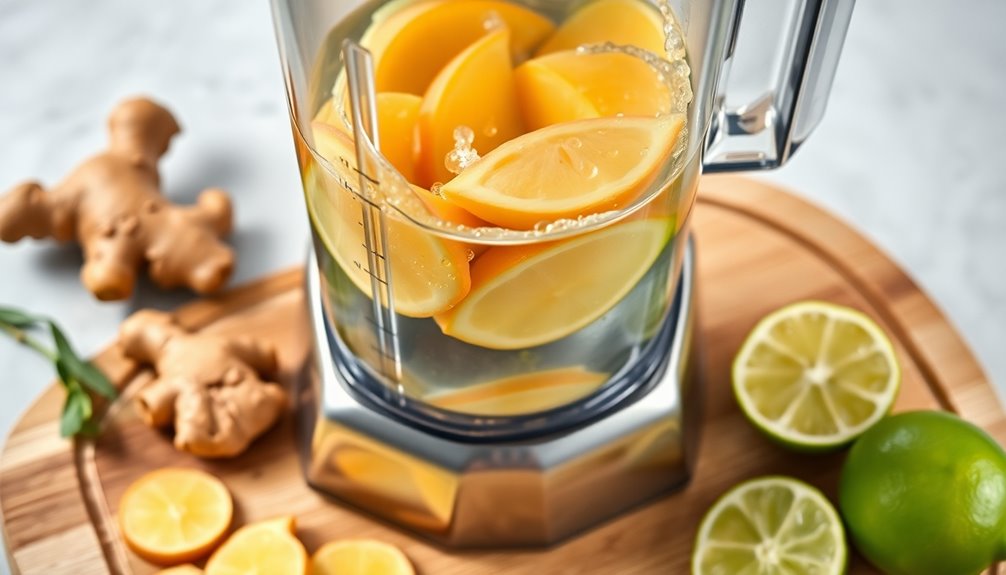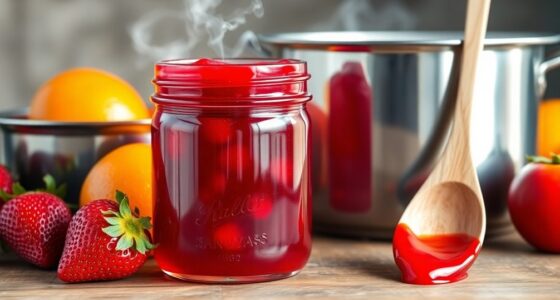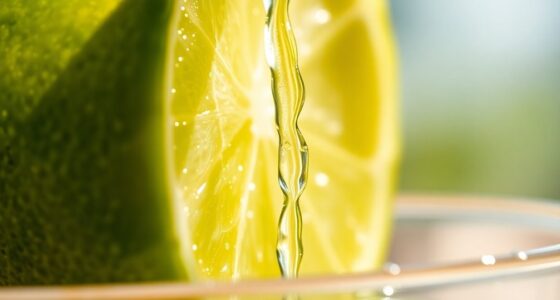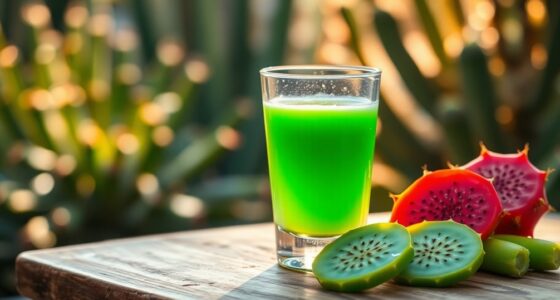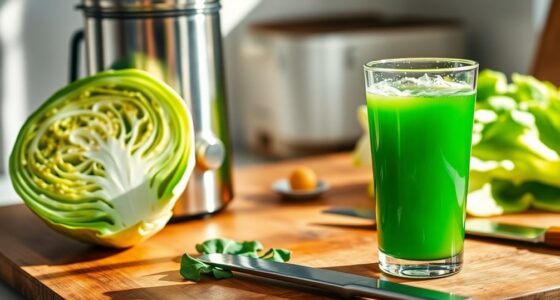To make ginger juice with a blender, start by washing and peeling 5 ounces of fresh ginger root. Chop it into 1-inch pieces, then blend it with 1 cup of filtered water for 30 seconds to 1 minute until smooth. Strain the mixture using a fine mesh strainer or cheesecloth to extract the juice. You can customize it with sweeteners or flavor enhancers. Store any leftovers in an airtight container or freeze in ice cubes for later use. There's more to discover about flavoring options!
Key Takeaways
- Wash and peel 5 ounces of fresh ginger root, then chop it into 1-inch pieces for easy blending.
- Blend the chopped ginger with 1 cup of filtered water on high speed for 30 seconds to 1 minute until smooth.
- Strain the blended mixture using a fine mesh strainer or cheesecloth to separate the juice from the pulp.
- Store the fresh ginger juice in an airtight glass container in the refrigerator for up to a week, or freeze in ice cube trays.
- Customize your ginger juice by adding sweeteners, coconut water, or lemon juice according to your taste preferences.
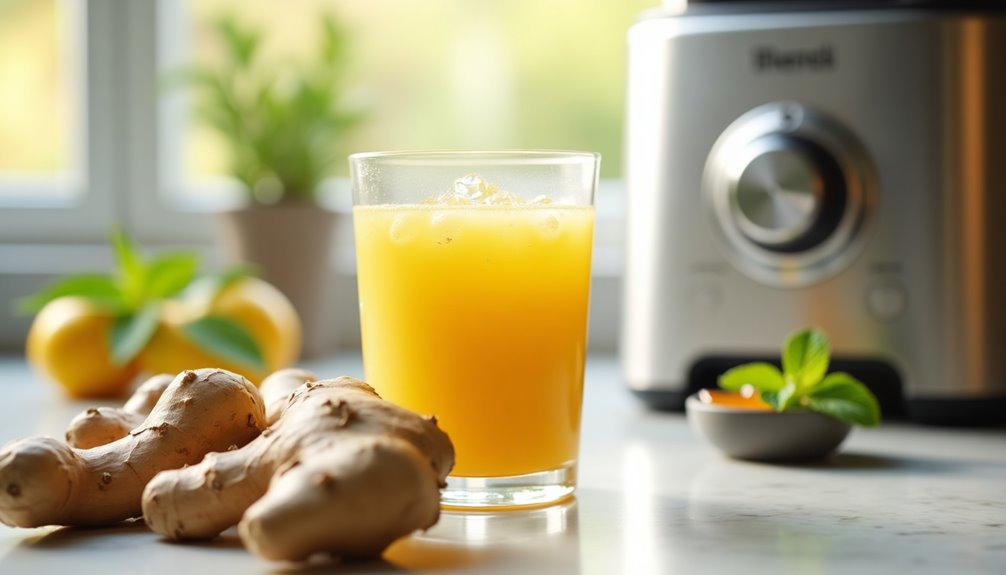
If you want a refreshing and health-boosting drink, making ginger juice at home is a simple and rewarding process. This homemade ginger juice recipe won't only quench your thirst but also provide numerous health benefits. Ginger is known for its anti-inflammatory properties, aiding digestion, and boosting the immune system, making it a fantastic addition to your daily routine. With a few steps and some basic ingredients, you can whip up this delicious juice.
Start by gathering your ingredients. You'll need about 5 ounces of fresh ginger root, which you can easily find at your local grocery store. Once you have your ginger, wash it thoroughly to remove any dirt.
Next, peel the ginger using a spoon or a vegetable peeler. This step is crucial, as it helps eliminate any bitterness and ensures a smoother juice. After peeling, chop the ginger into 1-inch pieces to make blending easier.
Now it's time to make ginger juice. Take your chopped ginger and place it in a high-speed blender. Add 1 cup of filtered water to the blender. The water not only helps in blending the ginger but also dilutes the juice to make it more palatable.
Blend the mixture on high speed for about 30 seconds to a minute, or until it's smooth. You'll know it's ready when there are no large chunks of ginger left.
Once blended, it's important to strain the juice to separate the liquid from the pulp. For this, you'll need a fine mesh strainer or cheesecloth. Pour the blended ginger mixture into the strainer, allowing the juice to drip into a bowl or jug below.
To extract as much juice as possible, press the pulp gently with the back of a spoon or your fingers. This step ensures you're getting all the goodness from the ginger.
After straining, transfer your fresh ginger juice into an airtight glass container. Store it in the refrigerator, where it'll stay fresh for up to a week. If you want to keep it longer, consider freezing the juice in ice cube trays. This way, you can easily pop out a cube whenever you need a quick ginger boost.
For enhanced flavor, don't hesitate to customize your ginger juice. You can add a sweetener like honey or maple syrup to balance the spiciness of ginger. Additionally, diluting the juice with coconut water or lemon juice can create a refreshing drink that's perfect for any occasion.
Frequently Asked Questions
How to Turn Ginger Into Liquid?
To turn ginger into liquid, start by washing the ginger root to remove dirt.
You can peel it if you want, but it's optional for organic varieties.
Chop the ginger into small pieces and blend it with water until it turns into a smooth paste.
After blending, strain the mixture using a fine mesh strainer or cheesecloth to separate the juice from the pulp. Once you have strained the mixture, you can enjoy the juice immediately or store it in the refrigerator for later use. Many people seek out cabbage juice for its health benefits, particularly in understanding how cabbage juice aids ulcers. The high concentration of glutamine in cabbage is believed to protect the stomach lining and promote healing, making it a valuable addition to a diet aimed at improving digestive health.
You'll have fresh ginger liquid ready for use!
Can Ginger Be Put in a Blender?
When it comes to blending ginger, you're in the right ballpark. You can absolutely toss ginger into a blender!
Just make sure you wash and chop it into smaller pieces to make blending easier. Add some water to help it along, and you'll be well on your way to extracting all those beneficial compounds.
After blending, don’t forget to strain the mixture to separate the juice from the pulp for a smooth finish. Once you have strained the mixture, you can pour the juice into a glass and enjoy its refreshing taste. For those interested in creating their own unique flavors, consider adding herbs or spices to enhance the profile of your beverage. By following these steps, you can easily make hippie juice at home and impress your friends with your culinary skills.
Can You Blend Ginger Instead of Juicing?
Yes, you can blend ginger instead of juicing it. Blending retains more fiber and nutrients, giving you a thicker, more textured juice.
Simply chop the ginger into 1-inch pieces, add water, and blend until smooth. After that, strain the mixture to separate the juice from the pulp.
This method not only saves ingredients but also allows you to repurpose the pulp in other recipes. Enjoy the versatile uses of your ginger juice!
Is It Better to Boil or Blend Ginger?
When it comes to ginger, you're really weighing the warmth of tradition against the vibrancy of freshness.
Blending ginger is generally the better choice, as it keeps all those beneficial compounds intact. You'll enjoy a richer flavor and more nutrients, especially gingerol, which can help reduce inflammation.
Plus, it's quicker and easier than boiling. So, if you want a zesty kick in your drink or dish, grab that blender!
Conclusion
Now that you've mastered the art of making ginger juice with a blender, your kitchen might just transform into a ginger juice paradise! Imagine the invigorating aroma filling the air while you sip on this zesty elixir that could potentially grant you superhuman energy. With just a few simple steps, you're not just enjoying a drink; you're unleashing a wave of wellness that could rival the powers of a thousand ginger warriors. So, blend away and embrace your inner juice guru!
Cindy thoroughly researches juicing trends, techniques, and recipes to provide readers with practical advice and inspiration. Her writing style is accessible, engaging, and designed to make complex concepts easy to understand. Cindy’s dedication to promoting the advantages of juicing shines through her work, empowering readers to make positive changes in their lives through the simple act of juicing.

